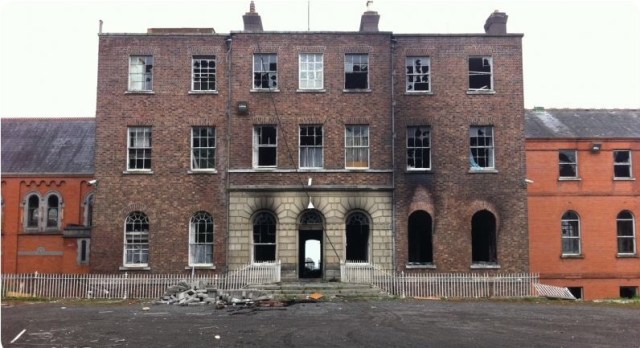
As some readers will be aware, over the last weekend two 18th century houses in Ireland suffered catastrophic and irreversible damage due to fire. Although in different parts of the country, what linked these two buildings was their connections to George Washington. Belcamp, on the outskirts of Dublin, dates from the mid-1780s when it was constructed by Sir Edward Newenham, a member of the Irish Parliament and ardent supporter of the American Revolution. In homage to which, he subsequently incorporated into his new residence an oval room modelled on that in the White House (itself designed by Irishman James Hoban in 1792). Furthermore in the grounds of Belcamp Newenham erected a miniature fort, the Washington Tower, built in honour and during the lifetime of the first President of the United States – and the first such monument erected to him anywhere.
Vernon Mount, County Cork has been discussed in detail here before (see Mounting Concern, January 14th 2013): its name is an obvious homage to Washington’s own home in Virginia, Mount Vernon. Contemporaneous with Belcamp, the house stands to the south of Cork city on a raised site with panoramic views over the Lee valley. Highly unusual in design – being a two-storey over basement villa, the curved entrance front having symmetrical convex bows on either side – Vernon Mount was likely designed by local architect Abraham Hargrave for Atwell Hayes a prosperous merchant involved in brewing, milling and glass manufacture. A particular feature of the house were its painted interiors by Nathaniel Grogan the elder who had spent a number of years in the United States before returning to his native city. Here he was commissioned to work on the decoration of Vernon Mount, including a ceiling painting on canvas in the drawing room. Within an octagonal frame, this depicted Minerva Throwing Away the Spears of War, a reference perhaps to the cessation of hostilities at the end of the American War of Independence. Around the central work were a series of lozenge-shaped panels and roundels featuring floral motifs, angels and centaurs. Meanwhile on the first floor, reached by a splendid cantilevered stone staircase with neo-classical wrought-iron balustrade, the oval upper landing was painted with eight marblised Corinthian columns interspersed with seven doors, each having a tromp l’oeil niche ‘containing’ classical statues and urns; these doors led to the house’s bedrooms and a concealed service staircase.
Both Belcamp and Vernon Mount have been allowed to stand empty for more than a decade, victims of the elements and of vandalism, since neither building was sufficiently maintained nor safeguarded. Now both are effectively ruins, with next to nothing left to salvage. In the year of a Presidential election on the other side of the Atlantic, one wonders how must our American friends view the way in which we Irish have allowed these historic links with one of their founding fathers to be squandered. The connection with George Washington ought to have been cherished and honoured, not least as a means of showing this country’s long-held belief in independence and self-government. Imagine how much the restoration of both buildings could have demonstrated the shared cultural values of our two countries: it must be asked why did not government, tourism bodies and others with a stake in promoting the state’s interests recognise so obvious an opportunity. Equally the relevant local authorities in both instances had the legal right to intervene and ensure the buildings were looked after and not allowed to fall into dereliction. Neither chose to exercise their legislative obligations and instead stood by while Belcamp and Vernon Mount slipped further and further into a pitiful condition before finally succumbing to fire. As an indictment of our state’s inability to care for its own heritage, and to recognise its own interests, the fate of these two buildings would be hard to surpass.
https://theirishaesthete.com/wp-content/uploads/2013/01/vernon-mount-8.jpg